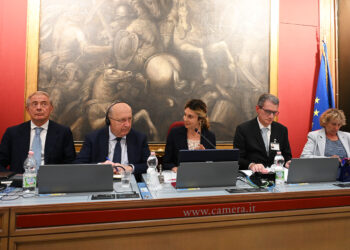Brussels – NATO is moving resolutely towards the 5 per cent target. The new goal of military spending as a proportion of GDP, unimaginable until before Russia’s large-scale invasion of Ukraine, is now almost a done deal, at least according to the Pentagon chief, Pete Hegseth, who is on his way to Brussels to meet his Alliance counterparts and prepare the ground for the summit in The Hague.
A meeting of the defence chiefs of the 32 member states is taking place today (5 June) at NATO headquarters in Brussels. The US Pete Hegseth—who, in an eloquent signal to European allies yesterday, deserted the meeting of the Ukraine Defence Contact Group (also known as the Ramstein Group), held in the same building—said he was “very encouraged” by the discussions. “The countries present are well above 2 per cent and we believe that we are very close, almost at consensus, to a 5 per cent commitment,” he said. “There are some countries that are not yet fully in agreement,” he admitted, adding that “we will convince them.”

For several months now, the White House of Donald Trump has been pressuring the members of the North Atlantic Alliance to significantly increase their defence budgets. Technically, the current target is set at two per cent of GDP, but the tycoon is demanding more than double the commitment. The Secretary General of NATO himself, Mark Rutte, had confirmed shortly after taking office that the current spending targets are no longer appropriate to the changed international geopolitical environment, especially (but not only) due to the aggressiveness of Vladimir Putin‘s Russia.
The summit of the heads of state and government of the organisation’s 32 member states, scheduled for 24–25 June in The Hague, will have to wait for the summit of the heads of state and government. Three weeks, therefore, remain to get all chancelleries to agree and change the minds of the most recalcitrant ones. Today’s ministerial meeting serves to prepare the ground at the technical level. “This will be a considerable additional investment,” said Rutte, also confident that, at the summit at the end of the month, “we will decide on a much higher spending target.”
Actually, the maxi-target of 5 per cent is ‘composite’: the actual defence budget is to be increased to 3.5 per cent, plus an additional 1.5 per cent of GDP to be devoted to defence-related capacities and activities, including specific infrastructure projects of high strategic value. But the specific details will probably be discussed until the last minute before the summit.

Currently, virtually all NATO countries, especially the European ones, are significantly increasing their defence spending. A year ago, in June 2024, eight chancelleries remained below the 2 per cent threshold: Belgium, Canada, Croatia, Italy, Luxembourg, Portugal, Slovenia, and Spain. Then the ‘Trump cyclone‘ turned the tables. Amidst threats of disengagement and flirtations with the Kremlin, the tycoon has essentially transformed the increase in military budgets from a political choice into a strategic necessity.
The Europeans have taken the hint: if they want to keep Uncle Sam involved in the Old Continent, they have to put their hands in their pockets. It is a paradigm shift of generational significance, albeit a belated one, at least according to some: Rutte himself recently sounded the alarm about the fact that Russia, which also has an economy 25 times smaller than that of the NATO countries combined, produces four times more ammunition.
Updated official figures on spending as a proportion of national GDP have not yet been published. Still, all member states appear to be on the verge of hitting or even exceeding the 2 per cent target agreed upon back in 2014, following the outbreak of the Russian-Ukrainian crisis. Madrid, which had long been the Alliance’s tail end, announced last April that it intends to reach the benchmark target by the end of the year.

However, while there seems to be basic agreement on the need to increase military spending, national governments are divided on the timing. Rutte speaks of 2032: for some members (above all the Baltics and Scandinavians), this is a horizon too far away, while for others it is too close. Giorgia Meloni has promised that Rome will reach 2 per cent before The Hague Summit. Still, according to Defence Minister Guido Crosetto, the Italian government agrees with the British one in pointing to 2035 as the ideal date for 5 per cent.
The minister also said that he “doesn’t know” whether his executive will request the activation of the safeguard clause of the Stability and Growth Pact, a possibility granted by the EU Commission as part of the ReArm Europe plan to allow the Twenty-Seven to take on debt in the defence sector without incurring infringement proceedings.
According to Crosetto, the suspension of SGP rules should last for “twenty or thirty years” to “make sense”. However, he argues, allocating funds is not enough: the problem is that “there is no production capacity to support the investments that we will have to make in the next few years, because the defence industry is still the same as it was three years ago.”
English version by the Translation Service of Withub






